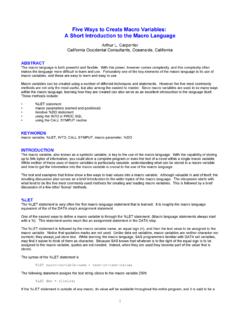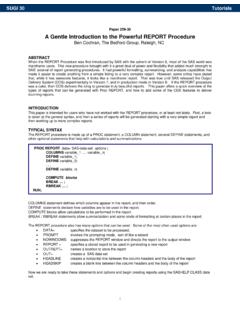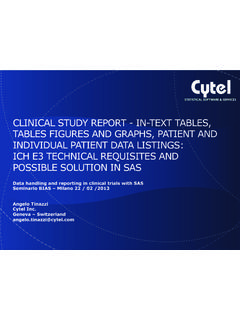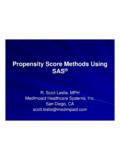Transcription of Advanced PROC REPORT: Traffic Lighting - …
1 1 Advanced PROC REPORT: Traffic Lighting - controlling Cell Attributes With your DataArthur L. CarpenterCalifornia Occidental ConsultantsABSTRACTC olor or shading is often used in a report table to attract the reader s eye to specific locations or items. The colorcan be fixed or it can be data dependent. Of course when the color or shading is dependent on the valuepresented in a given cell, manual construction of the table can be very tedious. Fortunately, with the advent of theOutput Delivery System, a number of new capabilities have become available to the SAS programmer. Theseinclude the ability to automatically control the color or shading of a particular cell of the table, and to even basethat control on the data itself. The control of cell attributes, such as foreground and background color, is known astraffic Traffic Lighting can be performed on tables generated by TABULATE and PRINT as well, PROC REPORThas the more sophisticated capabilities.
2 The CALL DEFINE statement is only available in the report step scompute block, and the STYLE= option is more complex. This paper will discuss the use of user defined formatswith the STYLE= option and the CALL DEFINE statement to control cell attributes. The discussion will includeinteractions with data summaries, computed variables, and various ODS destinations, such as RTF, PDF, andHTML .KEYWORDST raffic Lighting , CALL DEFINE, STYLE=, Formats, ODSINTRODUCTIONThe term Traffic Lighting refers to table items whose characteristics, such as background color, foreground color,font, and font size, change according to the value that is being displayed. Perhaps if a value is out of limits thenwe would like that cell to have a red background. This allows you to automatically highlight the values that youreally want your reader to implementation is both ingenious and simple.
3 We build custom formats using PROC FORMAT. Theseformats map the values of interest into style attributes. This makes changing the highlighted characteristics aseasy as changing a Traffic Lighting FORMATST raffic Lighting depends on customized formats. There is nothing special about these formats other than the factthat they resolve not to a value that is to be displayed, but rather to an attribute that will be interpreted when thereport is following PROC FORMAT will create two formats that can be used to control foreground and backgroundcolors. The formatted value (the item on the right of the equal sign) can be any of the style attribute format; value cfore low - 21000 = 'white' 21000< - 25000 = 'black' 75000 - high = 'white'; value cback2 low - 21000 = 'red' 21000< - 25000 = 'yellow' 75000 - high = 'green'; run;With these formats we would like to see values less than 21,000 to be displayed with white letters and a redbackground, while values over 75,000 will be displayed with a green background.
4 These two example formats areused throughout the examples in this paper, and are assumed to exist even if the PROC FORMAT step is notactually shown in each course even though these examples only change the foreground and background color, values for the otherattributes can also be specified. You can associate font, font size, and other attribute values through the use offormats. Other clever usages have even included links and images that are dependent on the value that FORMATS WITH THE STYLE= OPTIONThe report value that is to be displayed must be associated with a format and one way that this can be done isthrough the STYLE= option. In the following example the analysis variable ACTUAL has a FORMAT= option forthe display of the values and a STYLE= option which utilizes the Traffic Lighting formats to control the foregroundand background format; value cfore low - 21000 = 'white' 21000< - 25000 = 'black' >50000 = 'white'; value cback low - 21000 = 'red' 21000< - 25000 = 'yellow' >50000 = 'green'; run;ods listing close;ods html style=default path="&path\results" body=' ';title1 'Sales Summary';proc report data= (where=(prodtype='OFFICE')) nowd; column country region product actual; define country / group; define region / group; define product / group.
5 Define actual / analysis sum format=dollar8. 'Sales' style(column) = {background=cback. foreground=cfore.}; run;ods html close;A portion of the resulting table shows that values less than $25,000 are highlighted for quick recognition by thesales managers:3 Users will often try to apply the Traffic Lighting formats to all the data columns by placing the STYLE= option on theREPORT report data= (where=(prodtype='OFFICE')) nowd style(column) = {background=cback. foreground=cfore.};While this approach can work to some degree, it can and usually does, cause some problems as well. This isbecause report will attempt to apply the formats to all the columns including the grouping columns (REGION,COUNTRY, and PRODUCT) and in this case these are all character report in the previous example was fairly straight forward.
6 When we start adding summary lines, things canbecome more complex. If we add a BREAK and RBREAK statement to the report step, a logical extension ofwhat we did in the previous example, would be to add a STYLE(SUMMARY)= option to these two after country / summarize suppress style(summary) = {background=cback. foreground=cfore.};rbreak after / summarize style(summary) = {background=cback. foreground=cfore.};Unfortunately the timing is such that the execution of these statements and the resolution of the formats will NOTyield the desired results. When we want to provide Traffic Lighting for summary lines or even values underACROSS variables, we will usually need to use the CALL DEFINE statement.
7 Of course this statement can onlybe executed inside of a compute block, however, since we can assign a compute block for each column andsummary line we have the ability to use the CALL DEFINE. This is discussed in the following Traffic Lighting WITH CALL DEFINEThe CALL DEFINE statement can also be used in a compute block to create Traffic Lighting effects. The traffic4lighting in the first example in the previous section could also have been accomplished with a CALL DEFINE. Inthe following code a compute block containing a CALL DEFINE statement has replaced the STYLE= option on theDEFINE ACTUAL statement. ods listing close; ods html style=default path="&path\results" body=' '; title1 'Sales Summary'; proc report data= (where=(prodtype='OFFICE')) nowd; column country region product actual; define country / group; define region / group; define product / group; define actual / analysis sum format=dollar8.
8 'Sales'; compute actual; call define(_col_, 'style', 'style = {background=cback. foreground=cfore.}'); endcomp; run; ods html close; This code which uses the same formats as were established earlier in this paper creates the same table as in theprevious example. The compute block only exists to establish a location to place the CALL DEFINE statement. Certainly other executable compute block statements could also be placed in this compute Lighting IN THE PRESENCE OF COMPUTED VARIABLES AND SUMMARYLINESVery often the best way to produce Traffic Lighting for reports that include computed variables and/or summary lineswill be with a combination of CALL DEFINE statements and STYLE= the following examples we have complicated the previous examples by changing the PRODUCT variable to anACROSS variable, computed a product total, and have requested country and report summarizations.
9 We wouldlike the Traffic Lighting formats to be applied to all of the numeric values including summary lines and the are several ways that we can do this and it is worth discussing the differences between the approaches. Aswas mentioned earlier, we cannot just use the STYLE= option on the BREAK, RBREAK, or DEFINETOTALSALES our first attempt, in the following example we take the approach of assigning the attributes by columns for allrows (detail and summary).ods html style=default path="&path\results" body=' ';proc report data= (where=(prodtype='OFFICE')) nowd; column region country product,actual totalsales; define region / group; define country / group;5 define product / across; define actual / analysis sum format=dollar8.
10 'Sales' style(column) = {background=cback. foreground=cfore.}; define totalsales / computed format=dollar10. 'Total Sales' style(column) = {background=cback. foreground=cfore.}; break after region / summarize suppress; rbreak after / summarize; compute totalsales; totalsales = sum(_c3_, _c4_, _c5_); endcomp; run;ods html close; The PRODUCT is specified as an ACROSS variable (three columns). The three columns associated with the actual sales values are assigned these attributes. In the COLUMNS statement ACTUAL is nested under the across variable PRODUCTS. The same attributes are applied to the computed Total Sales the detail values have been formatted correctly the Traffic Lighting formats have been incorrectly appliedto the summary fairly simple tables, such as this, one way to apply the formatted style attributes to the summary lines is with theuse of the summary component on the STYLE= option STYLE(SUMMARY)= , as in the html style=default path="&path\results" body=' ';6proc report data= (where=(prodtype='OFFICE')) nowd style(summary)={background=cback.}









